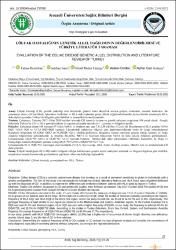| dc.contributor.author | Demirbaş, Fatma | |
| dc.contributor.author | Sanrı, Aslıhan | |
| dc.contributor.author | Çaltepe, Gönül Dinler | |
| dc.contributor.author | Comba, Atakan | |
| dc.contributor.author | Kalaycı, Ayhan Gazi | |
| dc.date.accessioned | 2022-02-18T20:55:56Z | |
| dc.date.available | 2022-02-18T20:55:56Z | |
| dc.date.issued | 2021 | en_US |
| dc.identifier.citation | DEMİRBAŞ F,SANRI A,ÇALTEPE G,COMBA A,KALAYCI A. G (2021). ÇÖLYAK HASTALIĞININ GENETİK ALLEL DAĞILIMININ DEĞERLENDİRİLMESİ VET ÜRKİYE LİTERATÜR TARAMASI. Kocaeli Üniversitesi Sağlık Bilimleri Dergisi, 7(1), 22 - 26. Doi: 10.30934/kusbed.737080 | en_US |
| dc.identifier.issn | 2149-8571 / 2149-8571 | |
| dc.identifier.uri | https://doi.org/10.30934/kusbed.737080 | |
| dc.identifier.uri | https://hdl.handle.net/20.500.12712/33007 | |
| dc.description.abstract | Amaç: Çölyak hastalığı (ÇH), genetik yatkınlığı olan bireylerde, glutene kalıcı duyarlılık sonucu gelişen, otoimmün, sistemik hastalıktır. Bu
çalışmanın amacı, ÇH’nin klinik, laboratuar özellikleri ve HLA doku tiplerinin geriye dönük değerlendirilmesidir.Ayrıca lieratür taramasıyla HLA
doku tipleri açısından Türkiye’de bölgelere göre farklılık ve benzerliklerin incelenmesidir.
Yöntem: Çalışmaya, Temmuz 2017- Ekim 2018 tarihleri arasında ÇH tanısıyla izlenen ve genetik çalışması uygulanan 104 çocuk alındı. Google
Scholarda Türkiye’de ÇH ve HLA genotiplendirme ile yapılan çalışmalar tarandı (n=11 çalışma) ve bölgelere ayrıldı.
Bulgular: Çalışmaya alınan 104 hastanın 67’si kız (%64,4) ve ortalama tanı yaşı 7,9±2,38 yıl(10ay-17,2yıl) idi. Hastalarımızın HLA grupları %59,6
DQ2, %26,9 DQ8 ve %13,4 DQ2+DQ8 saptandı. Literatürdeki çalışmalar bölgeler göre değerlendirildiğinde bizim de içinde bulunduğumuz
Karadeniz bölgesinde HLADQ2 %63,7 ve HLADQ8 %21,1 sıklıkla görülürken, bölgemize benzer oranlarda genotip sıklığı Akdeniz ve Doğu
Anadolu bölgelerinde görülmektedir. İç Anadolu HLADQ2 %87,4 ve Marmara bölgesinde %83,6 ile daha yüksek frekansta görülmektedir.
Çalışmamızda, DQA1*05 %65,4 ve DQB1*02 %12,5 oranında bulundu. Türkiye’deki diğer çalışmalarda (Marmara, Karadeniz, İç, Doğu ve
Güneydoğu Anadolu Bölgeleri) görülme sıklığı DQA1*05%69,8 ve DQB1*02 %27,7 idi.
Çalışmamızda HLA DQB1*02 homozigot olan hastalarda (%12,5) boy kısalığı, ishal, demir eksikliği anemisi, Marsh3 evre ve akrabalarında ÇH
daha yüksekti.
Sonuç: Çölyak hastalığında HLA-DQ analizi bölgesel sıklığın belirlenmesi genetik analiz maliyetini azaltmak ve bölgesel dağılıma göre özellikle
semptomsuz tarama hastalarında genotiplenme yapılması erken tanı kolaylığı sağlayabilir. | en_US |
| dc.description.abstract | Objective: Celiac disease (CD) is a systemic autoimmune disease that develops as a result of permanent sensitivity to gluten in individuals with a genetic predisposition. The aim of this study is to retrospectively evaluate the clinical, laboratory features and HLA tissue types of patients followed up with the diagnosis of CD. In addition, to examine the differences and similarities between patients with HLA types by region in Turkey. Methods: Totally 104 children, diagnosed as CD and genetically studied, were followed up between July 2017-October 2018.The studies of CD and HLA genotyping were scanned from Google Scholar (n=11) and divided into regions. Results: Of the 104 patients included in the study, 67 were female (64.4%) and the mean age of diagnosis was 7.9±2.38 years (10months-17.2years). HLA groups of our patients were 59.6% DQ2, 26.9% DQ8 and 13.4% DQ2+DQ8. When the studies of literature evaluated according to the regions, frequency of HLA DQ2 and HLA DQ8 in the Black Sea region, where our study located too, are found to be 63.7% and 12.8%, respectively. The genotype frequency at rates similar to our region are observed in the Mediterranean and Eastern, Anatolian regions. In the Central Anatolian HLA DQ2 was seen 87.4% and Marmara region, HLA DQ2 was seen with a higher frequency of 83.6%. In our study, the frequency is inferred 65.4% for DQA1*05, and 12.5% for DQB1*02 allele. According to the studies in Turkey (Marmara, Black Sea, Central, Eastern, and Southeastern Anatolia Regions), the average frequencies of DQA1*05 and DQB1*02 are 69.8% and 27.7%, respectively. In our study, patients with HLA DQB1*02 homozygous alleles (12.5%) had a higher rate of occurrence of shorter height, diarrhea, iron deficiency anemia, Marsh stage 3, and the risk of CD in their relatives. Conclusion: Determining the regional frequency of HLA-DQ analysis in CD reduces the cost of genetic analysis and provides the convenience of early diagnosis especially in screening patients without symptoms, according to the regional distribution. | en_US |
| dc.language.iso | tur | en_US |
| dc.publisher | Kocaeli Üniversitesi Sağlık Bilimleri Enstitüsü | en_US |
| dc.relation.isversionof | 10.30934/kusbed.737080 | en_US |
| dc.rights | info:eu-repo/semantics/openAccess | en_US |
| dc.subject | Çölyak hastalığı | en_US |
| dc.subject | Genotiplendirme | en_US |
| dc.subject | HLA | en_US |
| dc.subject | Türkiye | en_US |
| dc.subject | Celiac disease | en_US |
| dc.subject | Genotyping | en_US |
| dc.subject | Turkey | en_US |
| dc.title | Çölyak hastalığının genetik allel dağılımının değerlendirilmesi ve Türkiye literatür taraması | en_US |
| dc.title.alternative | Evaluation of the celiac disease genetic allel distribution and literature review of Turkey | en_US |
| dc.type | article | en_US |
| dc.contributor.department | OMÜ, Tıp Fakültesi, Cerrahi Tıp Bilimleri Bölümü | en_US |
| dc.contributor.authorID | 0000-0003-1788-2559 | en_US |
| dc.contributor.authorID | 0000-0003-1898-0898 | en_US |
| dc.contributor.authorID | 0000-0001-8525-6352 | en_US |
| dc.contributor.authorID | : 0000-0002-8576-9550 | en_US |
| dc.contributor.authorID | 0000-0003-2104-6801 | en_US |
| dc.identifier.volume | 7 | en_US |
| dc.identifier.issue | 1 | en_US |
| dc.identifier.startpage | 22 | en_US |
| dc.identifier.endpage | 26 | en_US |
| dc.relation.journal | Kocaeli Üniversitesi Sağlık Bilimleri Dergisi | en_US |
| dc.relation.publicationcategory | Makale - Ulusal Hakemli Dergi - Kurum Öğretim Elemanı | en_US |
















